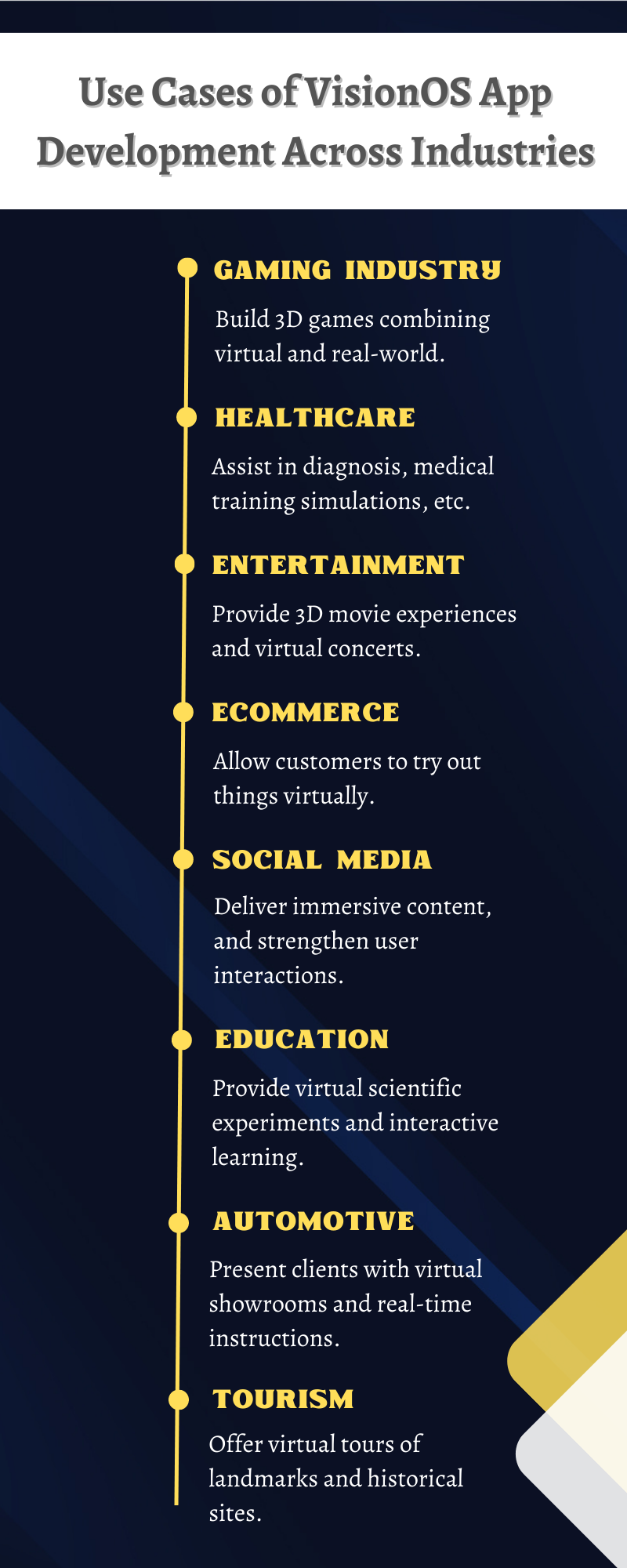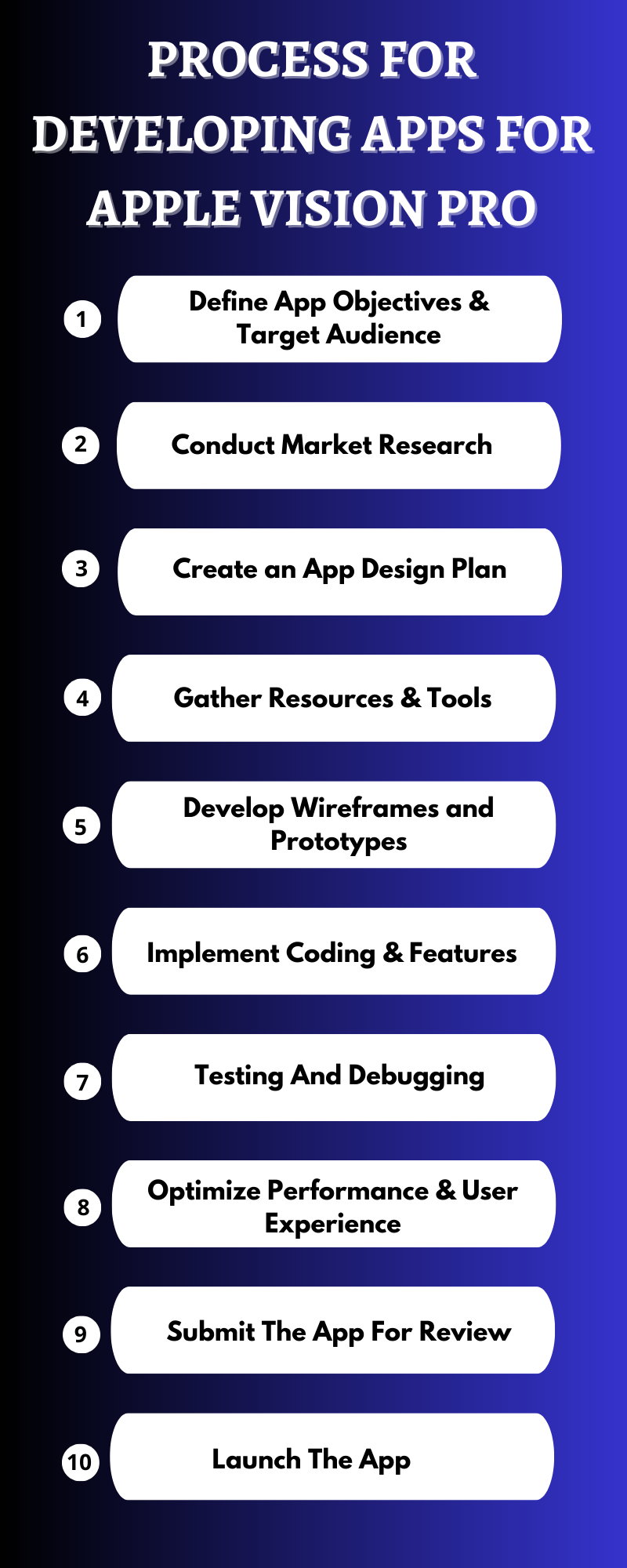Apple’s long-awaited VR move eventually saw daylight in the form of Vision Pro. This platform is poised to redefine how people engage with technology, much like how the iPod revolutionized the way we consume music and the iPhone reinvented our digital life.
Similarly, visionOS is going to lead the path in app development services because of its groundbreaking spatial computing capabilities, ergonomic design principles, and visual language that fits with Apple’s current ecosystem. Spatial computing is a digital technology to make computers interact seamlessly in a 3D environment using AR, VR, & mixed reality.
But what does this mean for your startup?
According to reports, the global AR and VR market size was USD 37 billion in 2022 and is expected to reach USD 114.5 billion by 2027, with a growth rate of 25.3%. Therefore, understanding the possibilities of the visionOS app development is essential if you’re a business owner trying to remain ahead of the curve. It’s imperative to demystify the key features and know-how to develop apps for Apple vision pro aligned with your business objectives.
What is VisionOS?
Apple visionOS, unveiled at WWDC 2023 with the Apple Vision Pro headset, is a spatial operating system designed to power the company’s entire AR/VR ecosystem. The OS ushers in a new era for Apple even though it shares certain fundamental architectural elements with MacOS and iOS technology.
The Vision Pro will utilize visionOS to give users an innovative three-dimensional user interface. It will offer a limitless canvas for collaboration, productivity, and entertainment.
The immersive mixed-reality interface lets users control applications with their hands, eyes, and voice by reducing latency and transforming interactions.
According to Apple, the operating system will free apps from the constraints of a display. Furthermore, it will create a format that really immerses users in the real world through digital content.
A Deep Dive Into Apple’s VisionOS Features
Apple visionOS is the fundamental layer that gives users access to use Vision Pro headset. It utilizes a specially engineered Apple Silicon dual-chip design and drives an ultra-high-resolution display system with 23 million pixels divided into two portions.
People will be able to explore and engage with various 3D content assets (videos, music, photos, documents, and other digital media stored digitally) and experiences.
The operating system blends a steady, consistent image with floating UI elements and audio ray tracing for multi-sense immersion. Thanks to the rich ecosystem’s ability to react dynamically to natural lights and shadows, you can better understand the scale and distance.
Users can benefit from an infinitely scalable digital environment and be adaptable to different use cases. Among the main features revealed at Apple’s WWDC 2023 panel are:
- Popular iOS and iPad apps will have native compatibility at the launch
- A suite of app development frameworks that are friendly to developers
- Facial scanning in real time to create avatars
- Audio engines with spatial ray-tracking for 3D sound
- Recording and playing 3D video
- IR EyeSight presence and eye tracking
- Dynamic adaptation of light and shadow
- 3D engine with many apps for multitasking
- Interaction with a virtual keyboard and audio dictation
Harnessing the Potential of VisionOS Application Development
Apple’s Vision Pro device and visionOS would definitely want to get a piece of the pie after Meta announced the planned release of the new Quest 3 headset. VisionOS will initially support thousands of iPad and iOS apps in addition to more in-demand apps such as Adobe Lightroom.
1. FaceTime is one of the initial applications that lets users communicate with virtual versions of their contacts in a mixed-reality space. Apple will enable users to click and share pictures and videos via the Vision Pro 3D camera.
2. The tech behemoth also disclosed that it is collaborating with media firms to add more content to the new visionOS App Store.
3. Based on the WWDC demos, Disney has stated that it will work with Apple to add immersive functionalities to Disney+ content, and even ESPN is likely to follow.
4. Apple’s visionOS app development also offers the opportunity to enterprises. In Apple’s Vision Pro demonstrations, users collaborated to send messages and interact with Safari windows. It can be a sign that Apple wants to gain access to the enterprise XR market.
5. “EyeSight” is a fascinating feature that will appeal to startups and entrepreneurs. The Vision Pro headset projects the wearer’s eyes on the outside of the visor as someone approaches, enabling seamless interactions.
6. Additionally, Apple visionOS has a tonne of new security features. For instance, Optic ID will authenticate users by scanning their irises. The biometric approach uses the Secure Enclave subsystem built into Apple’s system-on-chips to secure data.
The Advantages of VisionOS Compatible Apps for Businesses
There are many benefits that enterprises can get after building visionOS apps. Let’s look at some significant ones.
-
Reach a Wider Audience
Apps with visionOS support provide users with engaging, immersive experiences. With a wider reach, more clients would be reached, new markets could be explored, and a company’s brand visibility would develop, contributing to growth and success.
-
Improve User Engagement
Users receive rich and interactive experiences with AR app development. In today’s cutthroat business environment, a better user engagement channel results in higher customer satisfaction, brand loyalty, and financial success.
-
Boost Startup Revenue
These applications offer distinctive and compelling experiences that draw in and retain users. Startups could increase conversions, boost sales, and make significant financial gains by improving user engagement.
-
Customization and Scalability
AR App Development offers the flexibility to tailor the user experience to specific brand requirements, ensuring a unique and personalized touch. Additionally, VisionOS apps can scale seamlessly to accommodate growing user demands, allowing businesses to adapt and expand.
-
Stay Ahead of The Competition
Businesses could provide their clients with unique viewing opportunities. It distinguishes them from peers, builds brand recognition, and positions them as sector leaders, resulting in continuing success in a continually changing market.
Use Cases of VisionOS App Development Across Industries
VisionOS app development has a wide range of use cases across various industries. From augmented reality experiences to data visualization and virtual tours, VisionOS apps have the potential to revolutionize the way startups interact with their customers and deliver value in the digital landscape.
1. Gaming Industry
Gamers could indulge in an interactive gaming experience by playing 3D games that combine virtual and real-world components. Business owners could push the limits of creativity and offer thrilling experiences thanks to VisionOS technology.
2. Healthcare
To help in diagnosis and treatment planning, medical firms can use VisionOS apps for medical training simulations and improve learning results and the general standard of healthcare delivery.
3. Entertainment
Businesses could provide 3D movie experiences and interactive concerts. VisionOS apps revolutionize how consumers consume and interact with entertainment material by bringing a new degree of engagement and excitement.
4. eCommerce
By enabling product visualization, the VisionOS app development revolutionizes the eCommerce sector by allowing buyers to virtually try out things before purchasing. It enhances the shopping experience, boosts customer confidence, and reduces return rates.
5. Social media
Startups can create social media platforms with augmented reality (AR) elements to give users immersive content. VisionOS apps improve social media engagement by stimulating creativity and strengthening user interactions. AR filters to virtual experiences to social media engagement. With VR app development, businesses could foster creativity and enhance user connections.
6. Education
By using augmented reality (AR) to bring academics to life, VisionOS app development enhances education. Education can be more immersive, enjoyable, and effective by allowing students to participate in virtual scientific experiments and interactive learning.
7. Automotive
The automotive sector might provide clients with virtual showrooms where they can view and customize autos. In addition to giving real-time instructions and highlighting points of interest for a seamless driving experience, VisionOS apps can provide augmented navigation.
8. Tourism
The tourism industry can offer virtual tours of landmarks, historical sites, and cultural attractions. Users can explore destinations in augmented reality (AR), enhancing travel planning and providing a taste of the experience before visiting in person.

The Tech Stack Needed for Best VisionOS Apps
A robust tech stack is essential to develop the best visionOS apps. Leveraging the technologies ensures seamless integration of visionOS features and unlocks the full potential of augmented reality for exceptional app experiences.
| Apple Frameworks |
|
| Tools Required |
|
A Step-By-Step Process For Developing Apps For Apple Vision Pro
As a prominent app development service provider, we systematically ensure a well-planned and successful development. Our visionOS app developers create high-quality apps that leverage the powerful capabilities of Apple Vision Pro.
1. Define App Objectives & Target Audience
It includes identifying the precise objectives and purpose of the app, such as boosting productivity or resolving a particular issue. The ability to build a custom app that appeals to users depends on developers having a thorough understanding of the business needs and demographics of the target audience.
2. Conduct Market Research
Analyzing target demographics and spotting market trends and competitors are all part of market research. The app will resonate with the target demographic and stand out in a crowded market because of the insightful features, designs, and positioning this research provides.
3. Create an App Design Plan
The development of visionOS apps requires creating an app design plan. It entails defining the user interface, visual style, and app user experience. This strategy specifies the app’s organization, navigation, and essential features, guaranteeing a unified and user-friendly design that supports the app’s goals.
4. Gather Resources & Tools
Obtaining the VisionOS development kit, looking through pertinent documentation, and exploring the readily accessible frameworks and libraries are all part of this stage. Developers may take full advantage of the capabilities of VisionOS and speed up the app development process for the best outcomes by combining the appropriate resources and tools.
5. Develop Wireframes and Prototypes
This step will provide interactive models and visual representations of the user interface and functionality of the app. Before moving on to full-fledged production, these wireframes and prototypes enable early testing, feedback, and validation of design decisions, assuring a user-centric and intuitive app experience.
6. Implement Coding & Features
We convert the app’s concept into actual code, incorporating VisionOS features, functionality, and necessary elements. Swift programming expertise is required for this approach to run smoothly and adequately integrate VisionOS capabilities.
7. Testing And Debugging
A thorough testing process ensures the visionOS software runs without errors and bugs. Finding and addressing problems involves doing numerous tests, such as functional, usability, and performance testing. Before release, thorough debugging ensures a stable and reliable app, ensuring a high-quality user experience.
8. Optimize Performance & User Experience
Our VR app developers fine-tune the app’s performance to reduce loading times, maximize resource use, and guarantee fluid interactions. Our developers improve the app’s interface, responsiveness, and usability to provide a consistent user experience across all devices.
9. Submit The App For Review
We ensure the software complies with Apple’s requirements and quality standards to prepare it for submission to the visionOS Store. It incorporates the required metadata, summaries, screenshots, and test accounts for evaluation. After submission, Apple reviews the app to ensure it complies with their requirements.
10. Launch The App
Promoting the app, utilizing marketing techniques, and communicating with users are all necessary for a successful launch that will increase awareness and encourage downloads. It’s a huge milestone that widens the audience and gives users access to the app’s cutting-edge features and functionality.

What Lies Ahead for Apple VisionOS? (Upcoming Developments)
If Apple wants to compete in the XR market, the potential of visionOS must justify the price of Apple Vision Pro. Fortunately, Apple is already investing in potential areas for quick expansion.
It means that Apple vision pro app developers will have the resources to redesign existing applications and build new experiences in spatial space. In the upcoming months, there’s a good probability we’ll witness many businesses adapting visionOS.
Apple’s eagerly anticipated new OS will undoubtedly cause a lot of enthusiasm as AR developers continue to look for the next “iPhone moment.”
Although it’s tough to predict how successful this AR/VR platform will be for Apple, there is undoubtedly potential for digital transformation. Will visionOS’s exceptional capabilities enable Apple to avoid the flaws that other significant platforms in the sector have made? We won’t have to wait long because the Vision Pro is scheduled to hit the shelves in 2024.
SparxIT’s Expertise in Bringing Your VisionOS App Ideas to Life
SparxIT is your go-to partner for bringing your visionOS application ideas to life. With our expertise and experience in mobile app development, we know how to transform your vision into a fully functional reality. Our team of expert developers understands the intricacies of visionOS and stays updated with the latest trends and technologies.
We collaborate closely with you, ensuring a thorough understanding of your requirements and goals. From conceptualization to deployment, we meticulously handle every aspect, incorporating cutting-edge features, intuitive design, and seamless functionality. We make your visionOS app development project to reality and propel your business to new heights.
|
Frequently Asked Questions
Q1: What is visionOS app development, and how can it benefit my startup?
A: VisionOS app development refers to creating applications compatible with Apple’s VisionOS platform. By leveraging visionOS, startups can tap into advanced features like AR and computer vision to create unique user experiences. These cutting-edge capabilities can enhance products, engage customers, and differentiate your startup in the market.
Q2: How long does it take to build apps for visionOS?
A: The time required to build apps for visionOS can differ depending on various aspects, such as the app’s complexity, the features and functionalities involved, and the app development team’s experience. Typically, developing a visionOS application of superior quality can take anywhere from 4 to 7 months.
Q3: Can SparxIT bring my existing iPadOS or iOS app to the VisionOS platform?
A: Yes, our team ensures a smooth and seamless migration, preserving all the data and functionalities of your app while leveraging the unique features and capabilities of visionOS.
Q4: How much does it cost to make a VisionOS app?
A: The cost of developing a visionOS app depends on several factors, including the complexity of the app, the number of features, the design requirements, and the development team’s rates. Without thorough project specifications, it’s tough to give a precise price. It is recommended to consult with a professional app development agency to get accurate cost estimates.





